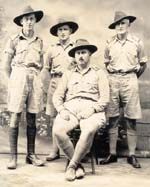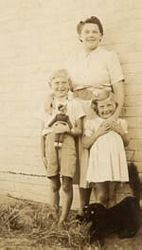People - John Finch Akeroyd
Major - A.I.F. 2/22 Battalion
Born: 17 December 1909 Brunswick, Victoria, Australia. Died: 17 December 1982 Frankston, Victoria, Australia.
On 10 July 1940 Dr Akeroyd enlisted and was attached as Regimental Medical Officer (RMO) to the 2/22 Battalion. He undertook military training at Trawool as a Captain. In March 1941 he was shipped on the Katoomba to Rabaul as a member of Lark Force, a token garrison sent to confront the might of the invading Japanese army and navy as it swept south and west through the islands.
The garrison was overwhelmed by the Japanese on 23 January 1942. Dr Akeroyd escaped and joined troops trying to withdraw to the North Coast of New Britain.
Douglas Aplin tells this part of the heroic doctor's story:
The force had lost its cohesion in the course of retirement as was inevitable in such country, in which small parties were likely to be more successful than otherwise ... The two companies directed by the battalion commander to the North Coast crossed the Keravat River in good order and it was this 220 plus that Akeroyd accompanied. As he went Akeroyd took some of the sick with him.
There was little food and the exhausting travel by foot tended to aggravate the position and the condition of the not-so-well or robust. This added its share of problems for Akeroyd in keeping the men mobile.
Some days later the gruelling climb through the mountains brought a good many men to St Pauls where Akeroyd set up a Regimental Aid Post for those unable to go on by reason of illness or exhaustion.
The Reverend Father B Stapleman, M.S.C pastor of St Pauls, Baining, had gone down the track to meet Akeroyd, who himself was walking with difficulty as he urged the failing soldiers along. ... It was late in the afternoon when Akeroyd arrived at St Pauls, when the rain was at its worst, but he refused all help for himself, not even a cup of tea, until his sick were attended to and the troops cared for.
Too, he refused a comfortable bed, resisting the pleas of other officers to spare himself and slept the night on a deck chair under a lean-to close to an infirmary overcrowded with 22 soldier patients.
He treated them all - bullet and shrapnel wounds and those injured on the track - even to a plaster cast for one with a splinter in his thigh, an almost impossible task considering the lack of facilities ...
As those under Akeroyd's care regained some measure of health they too moved on.
Akeroyd came to be admired by all the troops for his merry, amiable outlook, giving new hope to those tired and weary of life. He gave himself tirelessly to the sick, without bitterness or recrimination of any kind and refused to retreat, despite the persuasion of Father Stapleman and the nuns. His comment was 'As an officer and doctor I feel obliged to stick with my men as long as they need me.'
The two men, Akeroyd and Stapleman, yarned long into the night but at last the Japanese would be put off no longer and sent an order by native runner that Akeroyd and his patients should surrender at Massawa. Again, the doctor felt inclined to ignore the instruction, but feared reprisals against the mission.
The group stayed at Massawa until the troops were carried off to the prison camp at Rabaul, where it was reported that Akeroyd suffered beatings and ill treatment.
On 5 July 1942 captured officers and nurses were taken on board the Naruto Maru and transported to Japan, arriving late July. Dr Akeroyd was taken to the headquarters Stadium camp hospital at Ichioka in Osaka. It has been described by Lionel Wigmore in his official history as 'a cold place of cruelty, starvation and death.' It has been even more vividly described by John Glusman in his book Conduct Under Fire as the hell it was. This extract from his book sets the scene:-
The Japanese at Ichioka didn't just rifle Red Cross parcels, they stole them outright. ... There was no anaesthesia. For surgery Jackson (a Royal Navy volunteer) used a razor as a scalpel and a hacksaw blade for amputations, sterilizing them first in the water that had been boiled for rice. He turned to his corpsmen to hold down patients during operations.
The Mad Butcher of Ichioka was a man named Nosu. Jackson was beaten unconscious when he objected to one operation to be performed on a man. He was made to stand to attention for 24 hours and eventually removed to a lead mining camp. Next day John Akeroyd was appointed as senior medical officer.
By now the doctor was very ill himself, coughing constantly. One day he reported a theft of food by camp guards.
Tenko was scheduled for 2000 but it was later than usual that evening ... Fred, Akeroyd and Gonie (a Javanese pharmacist) stood before the morgue. Ambulatory patients were positioned in front of each hospital bay to report the number of bedridden men in them as Kato checked the muster. Akeroyd saluted but Kato refused to acknowledge him. Then Bando came around from behind and began hitting Akeroyd in the face. He screamed at the top of his lungs as he went down the row of prisoners, striking each one in turn. Kato unfastened his belt and worked Akeroyd over until Bando returned and started down the aisle of prisoners again.
The beating lasted ninety minutes, and then the three medics and a Sergeant Wicken were taken to an office and beaten again.
Dr Akeroyd also spent time as the camp medical officer at Taisho Camp, and was found to be seriously ill with tuberculosis. After liberation he spent two years in Heidelberg Repatriation Hospital and lost a lung. He returned to Frankston in 1947 and resumed his medical practice in 1948.
Dr Akeroyd was awarded the MBE on 6 March 1947 for his services to the sick and wounded and for staying behind with the wounded, even though offered the opportunity to escape.
A lesser man would have retired to a quiet life with his wife Barbara and two lively children, Robert and Margaret, but he was a caring man with a strong ethos of community service. Bob Akeroyd has supplied this list of the achievements of his remarkable father.
RSL Appointments:-
- State Council 1956-1982
- State Executive 1959-1982
- State Vice President 1964-1979
- Senior State Vice President 1979-1982
- President Frankston RSL 18 years
- Chairman of District Board 17 years.
Other:-
- Trustee of War Veterans Home for 20 years.
- Welfare Committee of Red Cross for 20 years.
- Vice President of Frankston Hospital
- Chairman of Elderly Citizens Association.
- President of Menzies Boys Home.
- Board of Management of Frankston Hospital for 31 years
- Council of Australian Medical Association for 9 years.
- Advisory Council of Frankston High School for 10 years.
- Continuous service on Council of Peninsula Legacy.
- Honourary Physician for Royal Melbourne and Prince Henry's Hospitals.
In January 1978 he was awarded the AM (Member of the General Division of the Order of Australia) for services to the community.
He saw many men lose their lives in the most hideous circumstances, and he also saved many men, for whom he was their best hope of survival.
Lest we forget.
Related Entries
Resources
Books
- Douglas Aplin, Rabaul 1942, The 2/22nd Battalion A.I.F. Lark Force Association, Melbourne, 1980, 295 pp.
- John Dawes, Every Man for Himself, The Catholic Press Newspaper Co. Ltd, 195?, 183 pp. In Part III, Beyond the Bainings, John Dawes describes the arrival of Major Akeroyd at St Pauls and the establishment of the aid post.
- John A. Glusman, Conduct Under Fire, Viking, New York, 2005, 588 pp.
- Lionel Wigmore, Australia in the War of 1939-1945, Series One Army, Volume IV: The Japanese Thrust, vol. IV of VII, Australian War Memorial, Canberra, 1957, 715 pp.
© The Akeroyd Family 2006
|


